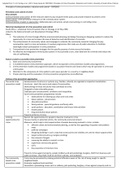Summary
Summary CMY2602 Principles of crime prevention, reduction and control Study notes
- Institution
- University Of South Africa (Unisa)
Study notes in preparation for CMY2602 Principles of crime prevention, reduction and control exam at UNISA
[Show more]



